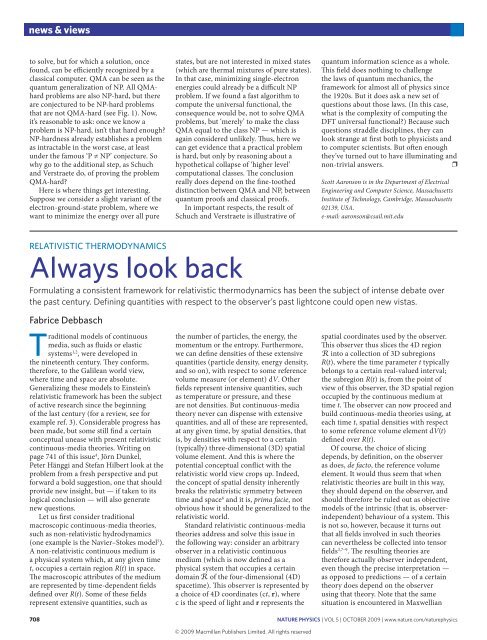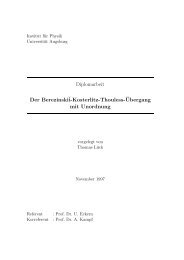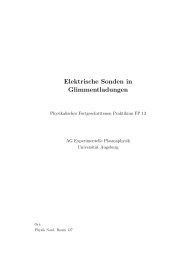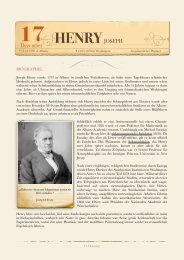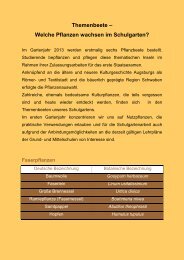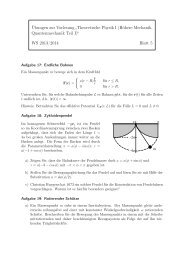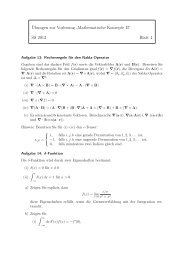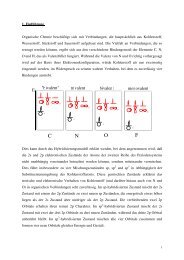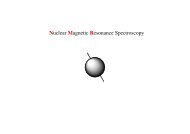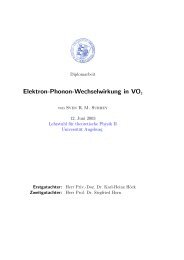Relativistic thermodynamics: Always look back - Institut für Physik
Relativistic thermodynamics: Always look back - Institut für Physik
Relativistic thermodynamics: Always look back - Institut für Physik
Create successful ePaper yourself
Turn your PDF publications into a flip-book with our unique Google optimized e-Paper software.
news & views<br />
to solve, but for which a solution, once<br />
found, can be efficiently recognized by a<br />
classical computer. QMA can be seen as the<br />
quantum generalization of NP. All QMAhard<br />
problems are also NP-hard, but there<br />
are conjectured to be NP-hard problems<br />
that are not QMA-hard (see Fig. 1). Now,<br />
it’s reasonable to ask: once we know a<br />
problem is NP-hard, isn’t that hard enough?<br />
NP-hardness already establishes a problem<br />
as intractable in the worst case, at least<br />
under the famous ‘P ≠ NP’ conjecture. So<br />
why go to the additional step, as Schuch<br />
and Verstraete do, of proving the problem<br />
QMA-hard?<br />
Here is where things get interesting.<br />
Suppose we consider a slight variant of the<br />
electron-ground-state problem, where we<br />
want to minimize the energy over all pure<br />
states, but are not interested in mixed states<br />
(which are thermal mixtures of pure states).<br />
In that case, minimizing single-electron<br />
energies could already be a difficult NP<br />
problem. If we found a fast algorithm to<br />
compute the universal functional, the<br />
consequence would be, not to solve QMA<br />
problems, but ‘merely’ to make the class<br />
QMA equal to the class NP — which is<br />
again considered unlikely. Thus, here we<br />
can get evidence that a practical problem<br />
is hard, but only by reasoning about a<br />
hypothetical collapse of ‘higher level’<br />
computational classes. The conclusion<br />
really does depend on the fine-toothed<br />
distinction between QMA and NP, between<br />
quantum proofs and classical proofs.<br />
In important respects, the result of<br />
Schuch and Verstraete is illustrative of<br />
quantum information science as a whole.<br />
This field does nothing to challenge<br />
the laws of quantum mechanics, the<br />
framework for almost all of physics since<br />
the 1920s. But it does ask a new set of<br />
questions about those laws. (In this case,<br />
what is the complexity of computing the<br />
DFT universal functional?) Because such<br />
questions straddle disciplines, they can<br />
<strong>look</strong> strange at first both to physicists and<br />
to computer scientists. But often enough<br />
they’ve turned out to have illuminating and<br />
non-trivial answers.<br />
❐<br />
Scott Aaronson is in the Department of Electrical<br />
Engineering and Computer Science, Massachusetts<br />
<strong>Institut</strong>e of Technology, Cambridge, Massachusetts<br />
02139, USA.<br />
e-mail: aaronson@csail.mit.edu<br />
RELATIVISTIC THERMODYNAMICS<br />
<strong>Always</strong> <strong>look</strong> <strong>back</strong><br />
Formulating a consistent framework for relativistic <strong>thermodynamics</strong> has been the subject of intense debate over<br />
the past century. Defining quantities with respect to the observer’s past lightcone could open new vistas.<br />
Fabrice Debbasch<br />
Traditional models of continuous<br />
media, such as fluids or elastic<br />
systems 1,2 , were developed in<br />
the nineteenth century. They conform,<br />
therefore, to the Galilean world view,<br />
where time and space are absolute.<br />
Generalizing these models to Einstein’s<br />
relativistic framework has been the subject<br />
of active research since the beginning<br />
of the last century (for a review, see for<br />
example ref. 3). Considerable progress has<br />
been made, but some still find a certain<br />
conceptual unease with present relativistic<br />
continuous-media theories. Writing on<br />
page 741 of this issue 4 , Jörn Dunkel,<br />
Peter Hänggi and Stefan Hilbert <strong>look</strong> at the<br />
problem from a fresh perspective and put<br />
forward a bold suggestion, one that should<br />
provide new insight, but — if taken to its<br />
logical conclusion — will also generate<br />
new questions.<br />
Let us first consider traditional<br />
macroscopic continuous-media theories,<br />
such as non-relativistic hydrodynamics<br />
(one example is the Navier–Stokes model 5 ).<br />
A non-relativistic continuous medium is<br />
a physical system which, at any given time<br />
t, occupies a certain region R(t) in space.<br />
The macroscopic attributes of the medium<br />
are represented by time-dependent fields<br />
defined over R(t). Some of these fields<br />
represent extensive quantities, such as<br />
the number of particles, the energy, the<br />
momentum or the entropy. Furthermore,<br />
we can define densities of these extensive<br />
quantities (particle density, energy density,<br />
and so on), with respect to some reference<br />
volume measure (or element) dV. Other<br />
fields represent intensive quantities, such<br />
as temperature or pressure, and these<br />
are not densities. But continuous-media<br />
theory never can dispense with extensive<br />
quantities, and all of these are represented,<br />
at any given time, by spatial densities, that<br />
is, by densities with respect to a certain<br />
(typically) three-dimensional (3D) spatial<br />
volume element. And this is where the<br />
potential conceptual conflict with the<br />
relativistic world view crops up. Indeed,<br />
the concept of spatial density inherently<br />
breaks the relativistic symmetry between<br />
time and space 6 and it is, prima facie, not<br />
obvious how it should be generalized to the<br />
relativistic world.<br />
Standard relativistic continuous-media<br />
theories address and solve this issue in<br />
the following way: consider an arbitrary<br />
observer in a relativistic continuous<br />
medium (which is now defined as a<br />
physical system that occupies a certain<br />
domain of the four-dimensional (4D)<br />
spacetime). This observer is represented by<br />
a choice of 4D coordinates (ct, r), where<br />
c is the speed of light and r represents the<br />
spatial coordinates used by the observer.<br />
This observer thus slices the 4D region<br />
into a collection of 3D subregions<br />
R(t), where the time parameter t typically<br />
belongs to a certain real-valued interval;<br />
the subregion R(t) is, from the point of<br />
view of this observer, the 3D spatial region<br />
occupied by the continuous medium at<br />
time t. The observer can now proceed and<br />
build continuous-media theories using, at<br />
each time t, spatial densities with respect<br />
to some reference volume element dV(t)<br />
defined over R(t).<br />
Of course, the choice of slicing<br />
depends, by definition, on the observer<br />
as does, de facto, the reference volume<br />
element. It would thus seem that when<br />
relativistic theories are built in this way,<br />
they should depend on the observer, and<br />
should therefore be ruled out as objective<br />
models of the intrinsic (that is, observerindependent)<br />
behaviour of a system. This<br />
is not so, however, because it turns out<br />
that all fields involved in such theories<br />
can nevertheless be collected into tensor<br />
fields 3,7–9 . The resulting theories are<br />
therefore actually observer independent,<br />
even though the precise interpretation —<br />
as opposed to predictions — of a certain<br />
theory does depend on the observer<br />
using that theory. Note that the same<br />
situation is encountered in Maxwellian<br />
708 nature physics | VOL 5 | OCTOBER 2009 | www.nature.com/naturephysics<br />
© 2009 Macmillan Publishers Limited. All rights reserved
news & views<br />
electromagnetism 10 , where the particle<br />
and current densities are spatial densities.<br />
They can, however, be represented as a<br />
tensor field, the so-called 4-current, and<br />
this makes the Maxwell theory compatible<br />
with Einstein’s theory of relativity. The<br />
same remark applies to all Yang–Mills<br />
gauge theories 11,12 , both quantum and<br />
non-quantum.<br />
Now, because the velocity of light<br />
is finite, a given observer at each point<br />
P(t) on his or her world line — the path<br />
on which the observer travels trough<br />
spacetime — will never have access to<br />
the whole 3D region R(t), but only to the<br />
interior of their past lightcone; this is a 4D<br />
subdomain of the 4D spacetime, and its<br />
intersection with R(t) is reduced to P(t). As<br />
a consequence, considering fields defined<br />
over R(t) and densities with respect to a 3D<br />
volume element defined over R(t) may not<br />
seem really physical. Dunkel, Hänggi and<br />
Hilbert 4 therefore suggest that R(t) should<br />
be replaced by the 3D past lightcone of the<br />
observer at point P(t). (This past lightcone<br />
reduces to R(t) when c tends to infinity, as<br />
is the case in the Galilean regime.)<br />
This idea seems indeed reasonable<br />
and it has the advantage of being<br />
arguably more physically sound than<br />
the conventional procedure. But still, it<br />
remains to be seen where this suggestion<br />
will lead us. Among the open issues<br />
are the following: first, from a purely<br />
mathematical or physical perspective, there<br />
is no problem whatsoever with integrating<br />
on a lightcone. However, it is impossible<br />
to average on a lightcone in an intrinsic,<br />
observer-independent manner (this is<br />
because lightcones are so-called null<br />
surfaces 13 , on which the normal vectors are<br />
also tangent vectors — remember that the<br />
relativistic line-element is not necessarily<br />
positive). All lightcone averages therefore<br />
involve an extra structure, typically the<br />
choice of an observer, and it is not clear if<br />
this constitutes a severe limitation or not.<br />
Second, when following in the footsteps<br />
of Dunkel, Hänggi and Hilbert 4 , it is<br />
tempting to revisit all Yang–Mills theories<br />
and connect them with lightcone densities.<br />
Will this be possible? And will it have any<br />
influence on how we view quantization?<br />
The future will tell.<br />
❐<br />
Fabrice Debbasch is in the Equipe de Relativité,<br />
Gravitation et Astrophysique (ERGA) of the<br />
Laboratoire d’Etude du Rayonnement et de la<br />
Matière en Astrophysique (LERMA), Université<br />
Paris 6, 3 rue Galilée, 94200 Ivry, France.<br />
e-mail: fabrice.debbasch@gmail.com<br />
References<br />
1. Landau, L. D. & Lifshitz, E. M. Fluid Mechanics (Pergamon, 1987).<br />
2. Landau, L. D. & Lifshitz, E. M. Theory of Elasticity<br />
(Pergamon, 1986).<br />
3. Israel, W. in <strong>Relativistic</strong> Fluid Dynamics (eds Anile, A. &<br />
Choquet-Bruhat, Y.) 152–210 (Lecture Notes in Mathematics,<br />
Vol. 1385, Springer, 1987).<br />
4. Dunkel, J., Hänggi, P. & Hilbert, S. Nature Phys.<br />
5, 741–747 (2009).<br />
5. Batchelor, G. K. An Introduction to Fluid Dynamics (Cambridge<br />
Univ. Press, 1967).<br />
6. Wald, R. M. Space, Time and Gravity (Univ. Chicago Press, 1992).<br />
7. Debbasch, F. Physica A 387, 2443–2454 (2008).<br />
8. Debbasch, F. & van Leeuwen, W. Physica A<br />
388, 1079–1104 (2009).<br />
9. Debbasch, F. & van Leeuwen, W. Physica A<br />
388, 1818–1834 (2009).<br />
10. Jackson, J. D. Classical Electrodynamics (Wiley, 1975).<br />
11. Dubrovin, B. A., Novikov, S. P. & Fomenko, A. T. Modern<br />
Geometry: Methods and Applications (Springer, 1984).<br />
12. Itzykson, C. & Zuber, J. B. Quantum Field Theory<br />
(Dover, 2006).<br />
13. Wald, R. M. General Relativity (Univ. Chicago Press, 1984).<br />
SAND SWIMMERS<br />
In silica in silico<br />
Swimming and flying are complicated<br />
processes to model, but at least the laws<br />
of fluid dynamics are known. In contrast,<br />
sand is a trickier medium to understand<br />
than water or air, because it can behave<br />
as a solid or as a fluid. Moreover, the<br />
presence of a ‘swimmer’ — such as the<br />
sand skink Plestiodon reynoldsi (pictured),<br />
seeking refuge from the heat of the<br />
Sun — changes the local properties of<br />
the sand, creating pockets of air and<br />
affecting the force chains between<br />
the granules. Consequently, there are<br />
no analytical equations of motion. To<br />
better understand the mechanism of<br />
swimming through a solid yet shifting<br />
medium, Takashi Shimada and colleagues<br />
have simulated the locomotion of<br />
a sand swimmer (Phys. Rev. E 80,<br />
020301; 2009), using a ‘push‐me‐pullyou’<br />
model (pictured moving to the<br />
right) introduced by Joseph Avron and<br />
colleagues (New J. Phys. 7, 234; 2005).<br />
In essence, the push‐me‐pull‐you<br />
model describes two disks connected<br />
by a spring. The disks inflate and shrink.<br />
To move forwards in fluid‐like sand,<br />
the smaller anterior disk inflates as<br />
the spring lengthens. The initially fully<br />
inflated posterior disk acts as an anchor<br />
in solid‐like sand. Once the anterior disk<br />
is fully inflated, it then acts as the anchor<br />
while the posterior disk shrinks and<br />
moves forwards as the spring contracts.<br />
To complete the move, the posterior<br />
disk inflates again, ready for the next<br />
stroke. Thus, a sand swimmer must deal<br />
with solidification near the anchor and<br />
fluidization near the moving disk at the<br />
same time.<br />
The simulation’s surprising result is<br />
that the optimal swimming frequency for<br />
maximum velocity is different from that<br />
for maximum efficiency. For example, if<br />
the swimmer moves too fast, the large<br />
voids created cause the swimmer to<br />
lose traction and slip. Hence the most<br />
efficient swimmer swims slowly. But<br />
move too slowly and the sand resolidifies<br />
before any forward motion<br />
can be completed. Unexpectedly, the<br />
simulation also provides information on<br />
the fundamental time scales associated<br />
with granular packing.<br />
MAY CHIAO<br />
© ALESSANDRO CATENAZZI<br />
nature physics | VOL 5 | OCTOBER 2009 | www.nature.com/naturephysics 709<br />
© 2009 Macmillan Publishers Limited. All rights reserved


